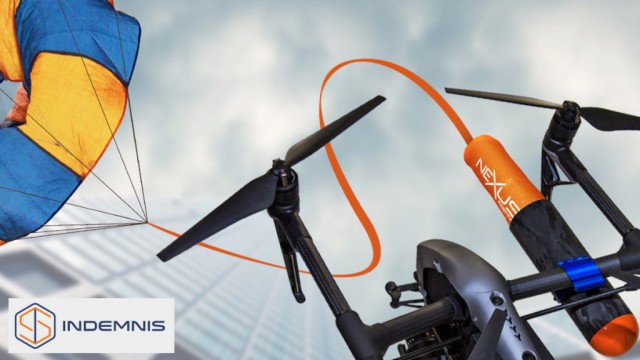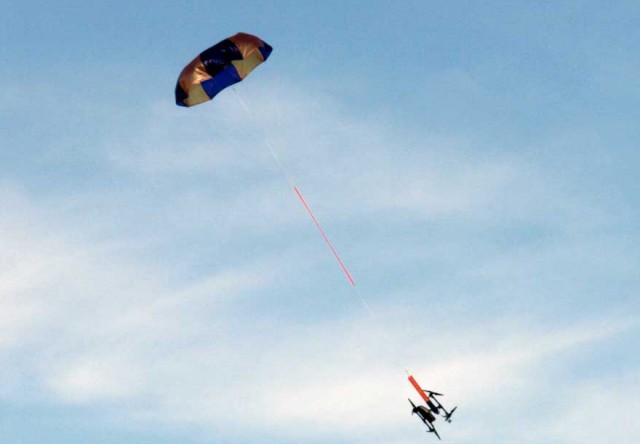Indemnis hopes to put its Nexus ballistic drone recovery system on the market by next summer. Company founder Alan Erickson said the system should retail for between $1,700 and $2,500 and satisfy upcoming FAA regulations for UAS flight over people and in urban areas for Part 107 commercial operations.
Erickson said Nexus would be scalable for UAS vehicles ranging from eight pounds to “several thousand.” He said the production Nexus system will automatically deploy within 30 milliseconds of either detecting a failure on the drone or unrecoverable flight and that the system “can detect the difference between flight and failure within six feet of vertical movement.”
Erickson co-founded Anchorage-based Indemnis (the Latin word for “without hurt, harm, or damage”) in 2014 and had previously operated a video production company. Indemnis began testing recovery systems in 2015 and subsequently began working with the FAA and other interested stakeholders to draft the regulatory standard for flight over people. The FAA is expected to release its draft of the standard for comment in early 2018. Erickson said the demand for operations over people is surging, and the number of Part 107 (commercial) operations is rising significantly. “The market is huge,” Erickson said, noting that the number of Part 107 pilots increased in the U.S. from 62,000 to 104,000 between September and December 2017 and that 80 percent of them want to fly over people. According to survey data, they are willing to pay for specialized equipment to enable such flights. Erickson said he easily sees a demand for 10,000 Nexus units per month by the end of 2018.
The need for such equipment has been borne out by University of Alabama and Virginia Tech research that showed a 70 percent chance of significant injury or death when a drone the size of a DJI Inspire 2 (weight 8.85 pounds) flies over people and fails, Erickson said. “Reality and perception are starting to catch up in the marketplace. There is no way the FAA is going to allow aircraft over people’s heads if there is no way to reliably ensure that the bird won’t hurt someone.”
PARACHUTE ALTERNATIVE
Erickson said the FAA has received more than 10,000 requests for flight over people in the last 14 months; and that all the ones that rely on parachutes for risk mitigation have been denied. Erickson said that conventional parachute systems don’t work for a variety of reasons, such as the tendency to become entangled with the aircraft or the need for it to be manually deployed. “The average human response to a failure is two to four seconds. If you are below 100 feet you’ve hit the ground every time.” He also said that current safety systems built into drones, such as automatically cutting the opposite engine in a quadcopter to prevent tumbling and slow descent by adding power to remaining engines, are insufficient for flight over people. “Now you’ve just got a spinning chainsaw coming down,” he said.
The Nexus system automatically detects failure, cuts engine power, and deploys a whole aircraft parachute within 30 milliseconds, slowing vertical speed to between 6.8 and 7.1 mph, a velocity sufficiently slow to allow the operator to catch the vehicle before it hits the ground. However, reducing vertical speed is only half the equation, Erickson said, noting that a vehicle under parachute will still move at the horizontal wind velocity, creating the potential for more damage. That’s why Indemnis is currently testing the Nexus parachute system in concert with an airbag on the DJI M600 (mtow 33.29 pounds). The bag turns the drone “into a giant pillow” once the chute deploys, beginning at eight inches above the blades. “We know that many M600 operators push it close to its maximum takeoff weight. If it is coming down horizontally at 25 mph you have a really big problem. That can cause some serious human injury,” Erickson said.
Erickson said that the FAA’s likely final standard for certifying recovery systems under Part 107 will be a rigid one. “The standard requires 45 tests in two failure modes—critical motor failure and full motor failure—at full flight speed, hover, and automatic and manual deployment scenarios. If you take a [DJI] Inspire 2 and you cut one motor, two motors, or four motors it just pitches violently and goes into a slow roll. [With] the same failure at 60 mph it will roll tight and violently. You have to pass all of those tests 100 percent. If you have a failure you have to start over after you explain the root cause of the failure. It’s a really strict testing standard.”
Nexus will come with operating limitations regarding temperature, precipitation, and unit shelf life and an operator training course. Erickson said it is likely that Nexus parachutes will need to be repacked every 180 days—the current federal standard for manned chutes—at the factory and that the company probably will allow customers to exchange timed-out systems for new/refurbished ones for a price to be determined. Indemnis plans to spool up its beta test program in early 2018. The final parachute system likely will be powered by a “hand safe” pyro generator as opposed to compressed air, as the former is less expensive and can legally be carried aboard passenger aircraft.
Source: AIN



What are the cost estimates for a VTOL, 8 rotor with hybrid power with a MTO weight of 250 pounds. What would be the minimum altitude for safe deployment? (50′, 100′ etc.)
Is the system a ballistic based deployment?
Regards,
Allen
Allen,
To contact the manufacturer, please click on the link to their website in the post…
To be honest, I am kinda skeptical this kind of solution would work, the video Indemnis released from the Virginia Tech conference shows a very long drop that would make this system unreliable at the typical drone altitude flight (around 60 ft).
The only way this would actually be relevant is if the parachute will prevent crash at a minimum altitude of 20-30 ft. the Indemnis deployment method with a long wire makes this impractical to really protect the drone or people underneath.
Kerry,
There’s a company called ParaZero and they have a solution that can provide this need at lower altitudes of 20 feet. I tjimk they have solutions from 2 pounds to 770 pound MTOW. Look at their web site http://www.ParaZero.com